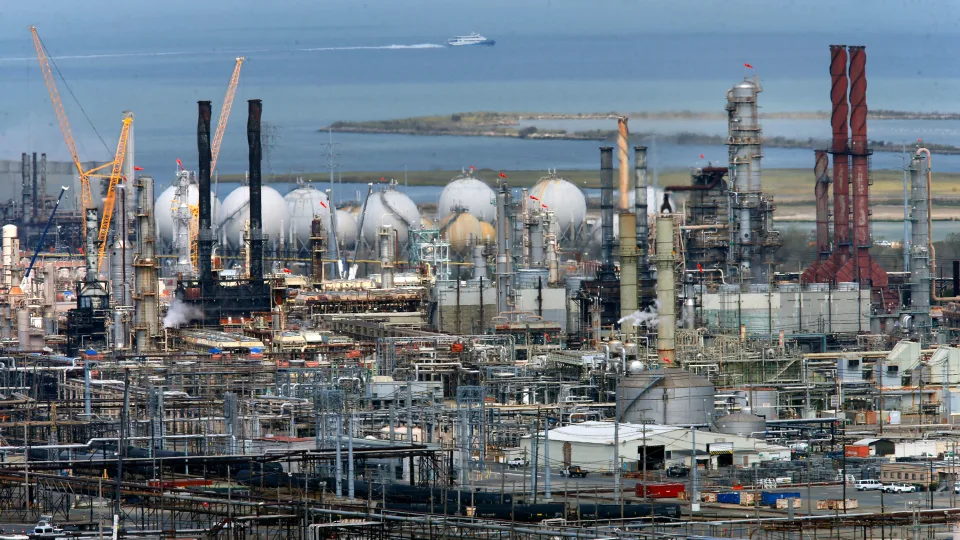Hundreds of hazardous industrial sites that dot the California coastline – including oil and gas refineries and sewage-treatment plants – are at risk of severe flooding from rising sea level if the climate crisis worsens, new research shows.
If planet-warming pollution continues to rise unabated, 129 industrial sites are estimated to be at risk of coastal flooding by 2050 according to the study, published Tuesday in the journal Environmental Science & Technology by researchers from University of California at Los Angeles and Berkeley, as well as Climate Central.
Researchers also found that residents living within a kilometer — about 0.6 miles — of these contaminated sites tend to be more vulnerable: people of color, the elderly, unemployed and low-income communities. By the end of the century, the number of at-risk toxic sites could increase to 423, and the disadvantaged population around those sites is expected to grow as well.
It’s the first study that takes a comprehensive look at a broad suite of hazardous sites impacted from rapidly rising seas, said lead author Lara Cushing, assistant professor of Environmental Health Sciences at UCLA.
“What’s notable is that there are certain types of facilities where a very large proportion of them are at risk, like oil refineries, which have been a focal point of environmental justice organizing and community concern about toxic exposures,” Cushing told CNN.
Explore the map: Hazardous facilities on the coast at risk to flooding
Amee Raval, a co-author of the study and the policy and research director of the Asian Pacific Environmental Network, said the findings are concerning because dangerous amounts of substances and contaminants typically flow out of these facilities when inundated by floods, polluting the land and air and often seeping into communities’ groundwater, underscoring previous flooding incidents that pummeled oil and gas facilities along the Gulf Coast.
“While climate change affects everyone, the experience really feels dramatically different depending on who you are and where you live,” Raval told CNN. “What this report really reinforces is that the oil refineries that bring sickness and death into our homes are also fueling the flames of climate change.”
Many of the hazardous sites this study highlights are clustered around large metro areas on the coast: San Diego and Los Angeles in Southern California; in the San Francisco Bay Area in Central California; and around Eureka in Northern California.
To improve their scientific findings, which are based on various government and academic databases including the Environmental Protection Agency’s Facility Registry Service, Cushing and the study’s researchers reached out to community members.
The groups involved, including the Asian Pacific Environmental Network, “led a series of webinars to share preliminary results and get feedback from a larger set of stakeholders,” Cushing said. “This type of approach, I feel, really improves the science and helps ensure that we’re asking policy-relevant questions of concern to potentially impacted communities.”
One of the things that came out of the meetings were concerns regarding groundwater. At first, researchers only looked at how rising sea levels affected surface water, but after hearing the community’s concerns, they set out to measure how much groundwater levels would rise in the future, and how it would move toxins further inland.
Kristina Dahl, a California-based climate scientist with the Union of Concerned Scientists who is not involved with the study, said it is “notable” that the study incorporated future changes in groundwater levels, given recent concerns over the West’s megadrought and over-pumping.
“Most studies of the future impacts of sea level rise look only at what happens above ground because data on groundwater can be limited and challenging to model,” Dahl told CNN. “By incorporating groundwater data, this study identifies hundreds of additional at-risk sties that will have heightened flood risk as sea level rises.”
Raval said it’s “not a coincidence” that toxic sites such as sewage treatment plants and oil and gas facilities are located in historically marginalized communities.
“We know that the boundaries around race and class closely aligns with hotspots of pollution,” she said. “These are communities that have been historically disinvested from and therefore have been dumping grounds for the extractive economy, because our communities didn’t have that political power to fight and resist that kind of placement of these facilities, but our organizing now is resisting that narrative.”
Dahl said the magnitude of sea level rise risk in the long term in places like California will depend on the choices people make today.
“Sea level will continue to rise even as we cut emissions, but we can see from this study that putting ourselves on a lower-emissions pathway could head off flood risk for dozens and dozens of toxic sites and the communities that surround them,” she said.
Hundreds of hazardous sites in California are at risk of flooding as sea level rises, study finds




